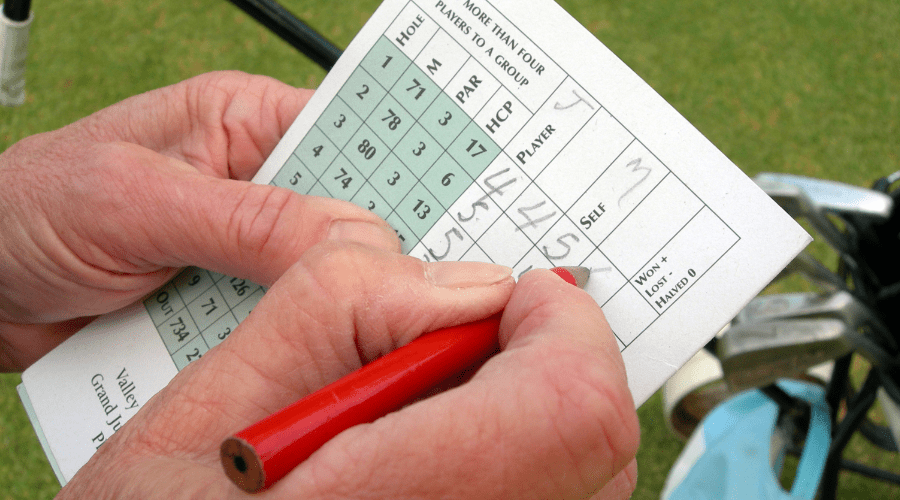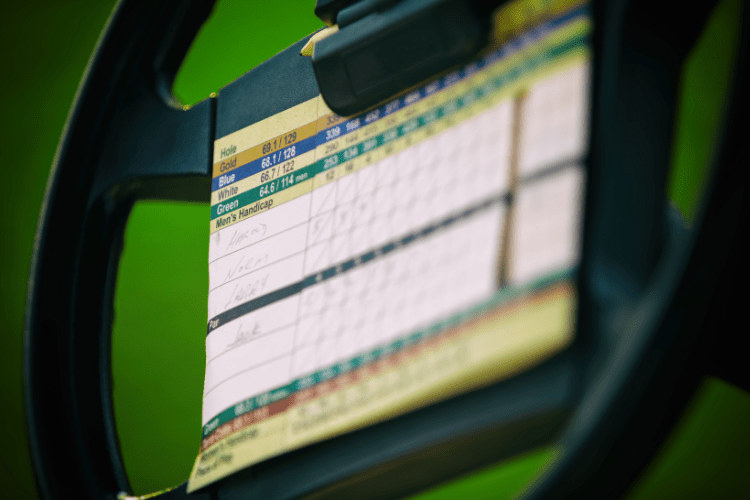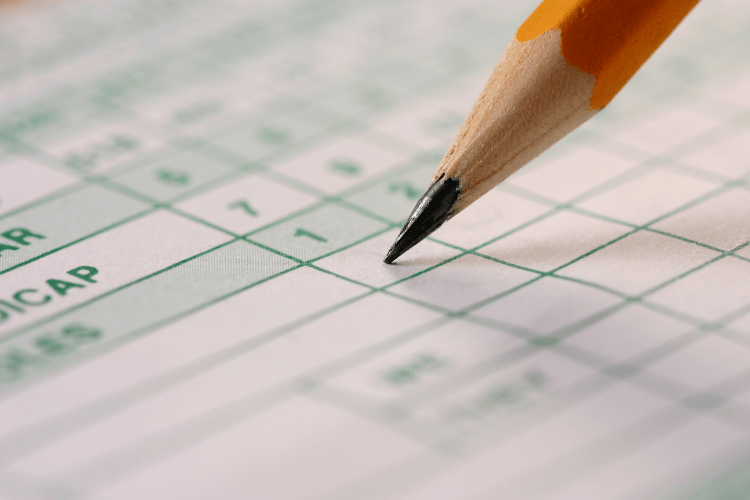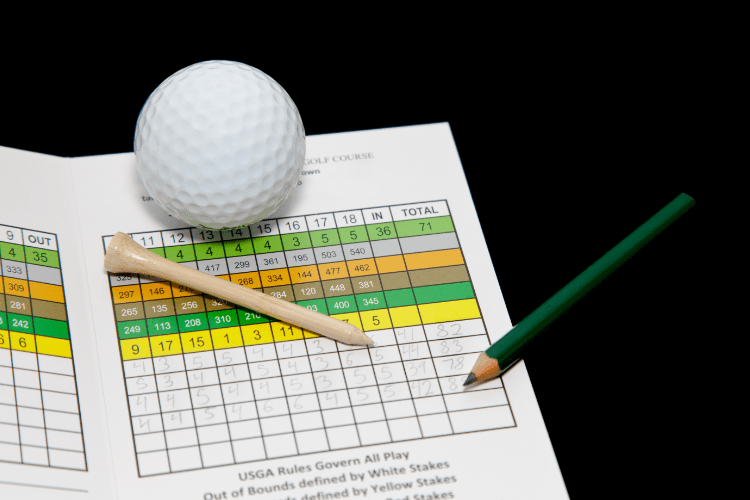How Golf Scoring Works: A Beginner’s Guide
Posted by

Golf scoring can feel like a secret code when you’re just starting out. What’s all the talk about strokes, pars, and scorecards?
The good news is once you understand the basics, it all starts to make sense.
At its core, the goal is simple: complete each hole in as few strokes as possible. Every swing is a chance to improve, and tracking your score helps you see your progress over time.
While it might seem complicated at first, golf’s scoring system follows a clear logic—and once you get the hang of it, you’ll be reading scorecards like a pro.
The Basics of Golf Scoring

Looking at a scorecard full of numbers can initially feel a little overwhelming. But at its core, golf scoring is simple: every stroke counts and the goal is to finish each hole in as few strokes as possible.
Think of it as a series of small challenges, where every shot is an opportunity to improve. Keeping track of your strokes helps you spot where small tweaks can lead to big improvements.
Here’s what you need to know:
- Every shot counts: The fewer strokes you take, the better your score.
- Par is your benchmark: Each hole has a set number of strokes (par) that an experienced golfer is expected to take. Your goal? Get as close to par as possible.
- Penalties matter: Hitting into the water, out of bounds, or taking an unplayable lie adds extra strokes. Learning to avoid these situations—or recover from them—can make a big difference.
- Smart strategy beats power: Even pros sometimes play it safe rather than taking a risky shot. Sometimes, laying up is the better move.
One of the best habits you can build as a beginner is keeping an honest stroke count. Writing down every shot helps you recognize patterns in your game, like:
- Consistently slicing off the tee
- Struggling with bunker shots
- Taking too many putts on the green
The good news? Identifying these patterns is the first step to fixing them. And if you want to improve faster, taking lessons from a great golf coach can make all the difference.
That’s where Skillest comes in. With access to top instructors worldwide, you can get personalized advice to sharpen your skills and lower your score with confidence.
What Is Par in Golf?

If you’ve ever heard golfers talk about “par” and wondered exactly what it means, you’re not alone. Simply put, par is the number of strokes an experienced golfer is expected to take to complete a hole.
It’s a helpful benchmark that gives you an idea of how challenging a hole might be.
- Par 3: Shorter holes, typically reachable in one shot, followed by two putts.
- Par 4: Medium-length holes that usually require a tee shot, an approach shot, and two putts.
- Par 5: Longer holes where most golfers take three shots to reach the green before putting.
Why Par Matters
Par isn’t just a number—it’s a great way to track your progress.
- If you finish a hole in the expected number of strokes, that’s par—a solid achievement!
- If you finish in fewer strokes, you’re under par, which is even better.
- If you take more strokes, you’re over par, but that’s totally normal—especially as you improve.
How Par Shapes Strategy
Par also influences how you play a hole. For example:
- On a par 5, you might use a driver off the tee, a fairway wood for your second shot, and a wedge to land on the green.
- On a par 3, one well-placed shot can put you near the hole, setting up a birdie opportunity.
- Some golfers rely on power, while others focus on accuracy and a solid short game to score well.
At the end of the day, par is a guideline, not a judgment. Some holes will challenge you more than others, and that’s part of what makes golf fun.
Common Golf Scoring Terms

Ever hear golfers throwing around golf terms like “birdie” or “bogey” and wonder what they mean?
These scoring terms might sound like a secret language, but they’re actually pretty simple—they just describe how many strokes you took compared to par.
Learning them will not only help you track your own scores but also make conversations on the course way more fun.
Birdies, Eagles, and Albatrosses
Hitting a great shot and finishing a hole under par? That’s when these exciting terms come into play:
- Birdie (-1): When you finish a hole one stroke under par. It’s a small victory that feels amazing, especially on a tough hole.
- Eagle (-2): Two strokes under par. These don’t happen every round, but when they do, they’re unforgettable. Usually, an eagle means a perfect drive and an even better approach shot.
- Albatross (-3): Also called a “double eagle,” this is three strokes under par. It’s super rare and typically requires holing out from the fairway on a par 5. If you get one, you’ll have a story to tell for life.
Bogeys and Double Bogeys
Not every hole goes as planned, and that’s totally normal. Here’s what happens when you take a few extra strokes:
- Bogey (+1): One stroke over par. It’s common in casual rounds and usually happens because of a missed putt or a tricky lie. No big deal—just a reminder of where you can improve.
- Double Bogey (+2): Two strokes over par. It might mean a tough bunker shot, an unlucky bounce, or a bad read on the green. Frustrating? Sure. But it’s also a chance to fine-tune your game.
The key thing to remember? Bogeys and doubles aren’t the end of the world—they actually help highlight areas to work on, whether it’s putting, approach shots, or course management.
Golf Scoring Formats

If you’ve only ever played traditional stroke play (the usual way of scoring golf), you’re missing out on some fun ways to mix up your rounds.
Different scoring formats can change the way you approach each shot, whether you want to take more risks, play as a team, or focus on winning hole by hole.
Here’s a breakdown of some popular formats so you can try something new with confidence.
Stroke Play
This is the standard way golf is played—every shot counts, and the goal is to finish all 18 holes with the lowest total score.
- Why play it? It rewards consistency and smart decision-making over an entire round.
- What to watch for? A few bad holes can add up, so staying mentally tough is key.
- Who is it for? Everyone! It’s the format used in most tournaments, but it’s also great for casual rounds.
Stableford
Stableford scoring takes the pressure off bad holes by giving points based on your score relative to par.
Instead of counting every stroke, you earn points:
- Birdie? Great! You get extra points.
- Bogey? No big deal, just fewer points.
- Disaster hole? Forget it and move on to the next one.
This format rewards aggressive play because one bad hole won’t ruin your entire round. If you like going for bold shots, this might be your new favorite way to play.
Match Play
Instead of adding up every stroke, match play treats each hole as its own mini-game. Whoever takes fewer strokes on a hole wins that hole.
- How does it work? Win more holes than your opponent, and you win the match—even if your total strokes are higher overall.
- Why try it? A bad hole doesn’t follow you around for the rest of the round. You start fresh on the next tee.
- Best for: Friendly competition because it keeps things interesting no matter how well (or… not so well) you’re playing overall.
Some golfers like to mix match play with stroke play for a more exciting round. It’s a great way to shake things up if your usual games are feeling repetitive.
The Handicap System

Golf is more fun when everyone has a fair shot at winning, and that’s exactly what the handicap system helps with. Whether you’re a beginner or a seasoned player, your handicap makes it possible to compete on equal footing with golfers of different skill levels.
What Is a Handicap, and Why Does It Matter?
Your handicap is a number that represents your expected number of strokes over par.
The lower your handicap, the fewer strokes you typically take. A beginner might have a handicap in the 20s or 30s, while a highly skilled golfer could be close to zero.
It matters because it keeps things competitive.
Instead of only playing against people at your exact skill level, you can challenge golfers of all abilities while keeping matches fair. If you have a higher handicap than your opponent, you’ll get extra strokes on certain holes to help balance the competition.
This way, a newer player can still enjoy a round with a more experienced golfer without feeling like they’re just chasing numbers.
Tracking Your Handicap
Keeping track of your handicap isn’t just about making games fair—it’s also a great way to measure your progress. Most golfers log their scores through official services or apps that calculate their handicap index automatically.
Consistency is key because regularly entering scores gives you the most accurate reflection of your game. Honesty matters, too—a handicap that’s too high or too low throws off competition and doesn’t truly reflect your skill level.
Watching your handicap drop over time is also a great sign that your practice is paying off.
Some golfers track every round, while others only submit scores from certain games—it’s flexible based on how you play.
Handicaps in Different Scoring Formats
The best part? You can apply handicaps to various scoring formats like Stableford or match play, making every round feel competitive, no matter who you’re playing with.
Stableford adjusts point scoring so a higher-handicap player still has a fair shot. Match play gives extra strokes where needed, so a close match stays exciting until the final holes.
Scorecards in Golf

A scorecard does more than record your score. It’s a useful tool for reflecting on your game. Noting each stroke keeps you focused, turning your round into a learning opportunity.
Many players mark good holes, like birdies, or note trouble spots, such as triple bogeys, to identify areas to work on.
If you’re struggling with bunkers, for example, it might be time for a sand wedge session. Seeing improvement in certain areas, like short irons, can motivate you to keep practicing.
You can use a physical scorecard or a digital app to track your progress. Looking over your scores afterward reveals patterns, like strong starts or shaky finishes, and can highlight where you need to adjust—whether it’s warming up better or resetting mentally.
Using Tech to Score Better

There are loads of tools nowadays that make it easier than ever to refine your skills.
Rangefinders and GPS watches take the guesswork out of club selection, while launch monitors can track swing speed, ball spin, and more—helping you practice smarter. With user-friendly gadgets, improving your score is easier than ever these days.
Digital coaching is another game-changer. Platforms like Skillest let you send swing videos to online golf instructors to get personalized feedback—no need to travel for lessons. Plus, having a video archive makes it easy to track your progress and revisit tips.
Tracking your stats after each round can also make a big difference. Apps that log shots, fairways hit, and putts help identify trends—whether it’s a recurring bunker struggle or shaky wedge play.
The more you understand your game, the more targeted (and effective) your practice sessions will be.
Golf Scoring Apps to Try
Digital scorecards simplify tracking strokes, putts, and penalties. Some offer detailed round comparisons, while others provide quick summaries—so you can choose what works best for you. Many even connect with online instructors for tailored advice.
Some apps also include friendly competition features, letting you challenge friends or set up small tournaments. A little rivalry can be a great motivator for consistent practice!
Enjoy Your Golf Journey

Golf is a game of ups and downs—some days, everything clicks, and other days, you’re reminded where you need to improve. That’s all part of the challenge (and the fun).
By understanding scoring, choosing a format that suits you, and using coaching tools like Skillest, you can keep improving without feeling overwhelmed. Progress happens one step at a time, and every round is a chance to learn.
With the right mindset and support, you’ll keep finding ways to lower your scores and build confidence on the course.
If you’re ready to take your game to the next level, Skillest‘s expert coaches are here to guide you—one swing at a time.
Frequently Asked Questions
What is the scoring system in golf?
Golf scoring is simple: the fewer strokes, the better. Each hole has a target number of strokes, called par. If you finish in fewer strokes, you’re under par; if it takes more, you’re over.
What are the seven common golf scoring terms?
The key ones to know are par, birdie, eagle, albatross, bogey, double bogey, and triple bogey. Par is the expected number of strokes for a hole.
A birdie is one stroke under par, an eagle is two under, and an albatross is three under. On the other side, a bogey is one stroke over par, a double bogey is two over, and a triple bogey is three over.
What is considered a birdie, a bogey, and an eagle?
A birdie is one stroke under par, a bogey is one over par, and an eagle is two under par. These terms help track how well you’re scoring relative to expectations for each hole.
How does a points-based game work in golf?
One popular format is Stableford, where you earn points based on how many strokes you take relative to par. The better you score, the more points you earn.
Unlike traditional scoring, a bad hole won’t completely derail your round, making the game more forgiving and strategic.
What is the average golf score?
The average golf score for recreational players is typically around 90-100 strokes for an 18-hole round. However, this can vary based on skill level, with beginners scoring higher and experienced golfers often shooting in the low 70s to mid-80s.
